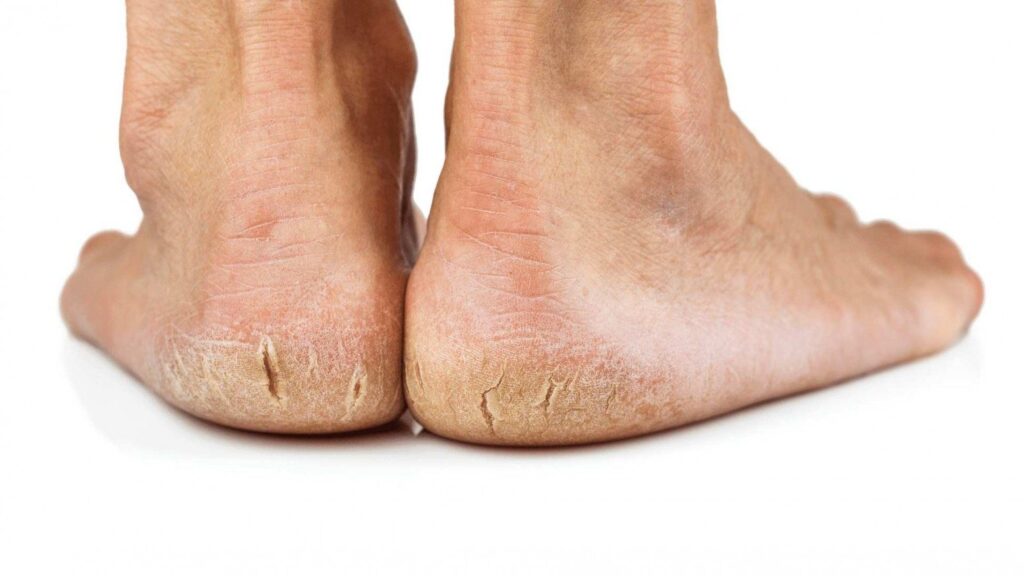Share Post
Understanding How Cracked Heels Form
Cracked heels, sometimes referred to as heel fissures, are a common foot issue that affects people of all ages. They are unattractive and uncomfortable, and if not addressed, they can progress to more serious issues.
Causes

Cracked Heels, commonly referred to as heel fissures, can have a variety of causes. The following are some typical causes:
Dehydration: Lack of water intake can make your skin dry and flaky.
Weather conditions: Dry skin is one of the most typical reasons for this foot disease. Your heels’ skin develops cracks when it is overly dry because it loses its elasticity and flexibility.
Long periods of standing: Long-standing jobs or activities, such as those performed by retail staff, medical professionals, or manufacturing workers, can raise the chance of developing this kind of foot disease. The skin on the foot may crack as a result of continual pressure.
Uncomfortable footwear: Cracked heels can be caused by wearing shoes with open backs or that don’t fit properly. The heels of these shoes don’t get the support and cushioning they need, which causes cracks to form.
Medical problems: The likelihood of developing cracked heels might be increased by underlying medical disorders including diabetes, hypothyroidism, or peripheral neuropathy (nerve damage), which can influence the health and moisture levels of the skin.
Obesity: The heels grow sideways under increasing pressure from carrying extra body weight. Cracks may form as a result of this expansion, especially if the skin is already dry or low in moisture.
Aging: The skin’s capacity to retain moisture declines with age, increasing its susceptibility to dryness and cracking. As a result, older people are more prone.
Foot hygiene: Poor foot care, such as failing to properly wash and moisturize the feet, can cause the skin to become dry and brittle. Ignoring simple foot care can make the issue worse.
Preventing and Treating
There are, fortunately, things you may do to avoid and remedy. Here are a few pieces of advice:
Regularly moisturize your feet: To maintain your skin soft and supple, apply a moisturizing cream or lotion to your feet every day.
Exfoliate your feet: Remove the dead skin on them using a pumice stone or foot file.
Wear cozy, well-fitting footwear: Opt for footwear that fits comfortably and offers adequate support.
Keep your skin moisturized: By drinking plenty of water.
Take cool showers instead of hot ones: Because hot water might dry up your skin.
Consult a doctor: Managing any underlying foot conditions or medical conditions that may contribute to dry skin. If it is severe, painful, or shows signs of infection. To avoid complications, consult a doctor or professionals immediately.
Finally, it should be noted that cracked heels are a typical issue with the feet that may be avoided and addressed with the right treatment. It’s crucial to keep up good foot cleanliness and regularly moisturize the feet.
Additionally helpful are well-fitted shoes and avoiding putting too much pressure on the heels. Consult a healthcare provider for the best course of action and advice if you have painful or severe cracks or underlying medical concerns.
Other natural remedies
Although there is no specific treatment for cracked heels, numerous home remedies are available that mainly concentrate on moisturizing and softening the skin.
- vinegar, for a foot soak
- olive or vegetable oil, to moisturize
- Shea butter, to moisturize
- mashed bananas, to moisturize
- paraffin wax, to seal in moisture
- oatmeal mixed with oil, for exfoliation
As a general rule, procedures are performed on an outpatient basis in an Alberta Health Services (AHS) approved Surgical Center or in a Hospital. Surgical procedural costs are covered by AHS or the patient may opt for private surgery to avoid a waiting time. A visit to Feldman Foot And Ankle Specialists will CLEARLY define all available patient options.

